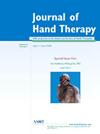The effect of muscle-biased manual therapy on shoulder kinematics, muscle performance, functional impairment, and pain in patients with frozen shoulder
IF 2.1
4区 医学
Q2 ORTHOPEDICS
引用次数: 0
Abstract
Background
Frozen shoulder (FS) is characterized by restricted active and passive shoulder mobility and pain.
Purpose
Compare the effect of muscle-biased manual therapy (MM) and regular physical therapy (RPT) in patients with FS.
Study Design
Pretest–post-test control group study design.
Methods
We recruited 34 patients with FS and compared the effect of 12-session MM and RPT. The outcome measures were scapular kinematics and muscle activation, scapular alignment, shoulder range of motion, and pain intensity. Two-way analysis of variance was used to examine the intervention effect with α = 0.05.
Results
Both programs resulted in similar improvements in pain and shoulder function. Compared to the RPT, MM resulted in increased posterior tilt (MM: 7.04°-16.09°, RPT: −2.50° to −4.37°; p = 0.002; ES = 0.261) and lower trapezius activation (MM: 260.61%-470.90%, RPT: 322.64%-313.33%; p = 0.033; ES = 0.134) during scaption, and increased posterior tilt (MM: 0.70°-15.16°, RPT: −9.66° to −6.44°; p = 0.007; ES = 0.205) during the hand-to-neck task. The MM group also showed increased GH backward elevation (MM: 37.18°-42.79°, RPT: 43.64°-40.83°; p = 0.004, ES = 0.237) and scapular downward rotation (MM: −2.48° to 6.80°, RPT: 1.93°-1.44°; p < 0.001; ES = 0.404) during the thumb-to-waist task, enhanced shoulder abduction (MM: 84.6°-102.3°, RPT: 85.1°-92.9°; p = 0.02; ES = 0.153), and improved scapular alignment (MM: 10.4-9.65 cm, RPT: 9.41-9.56 cm; p = 0.02; ES = 0.114).
Conclusions
MM was superior to the RPT regarding scapular neuromuscular performance. Clinicians should consider adding muscle-biased treatment when treating FS.
偏重肌肉的手动疗法对肩周炎患者的肩关节运动学、肌肉表现、功能障碍和疼痛的影响。
背景:肩周炎(FS)以肩部主动和被动活动受限及疼痛为特征:肩周炎(FS)以肩部主动和被动活动受限及疼痛为特征。目的:比较肌肉偏倚手法治疗(MM)和常规物理治疗(RPT)对肩周炎患者的效果:研究设计:前测-后测对照组研究设计:我们招募了34名FS患者,并比较了为期12个疗程的MM和RPT的效果。结果测量指标包括肩胛骨运动学和肌肉激活、肩胛骨排列、肩关节活动范围和疼痛强度。采用双向方差分析来检验干预效果,α = 0.05:结果:两种方案对疼痛和肩部功能的改善效果相似。与 RPT 相比,MM 增加了后倾(MM:7.04°-16.09°,RPT:-2.50°至-4.37°;p = 0.002;ES = 0.261),降低了斜方肌激活(MM:260.61%-470.90%,RPT:322.64%-313.33%;p = 0.033;ES = 0.134),并且在手到颈任务中后倾增加(MM:0.70°-15.16°,RPT:-9.66°至-6.44°;p = 0.007;ES = 0.205)。MM 组的 GH 后仰(MM:37.18°-42.79°,RPT:43.64°-40.83°;p = 0.004,ES = 0.237)和肩胛骨下旋(MM:-2.48°至 6.80°,RPT:-1.93°-1.44°)也有所增加:MM:-2.48°至 6.80°,RPT:1.93°至 1.44°;P在肩胛骨神经肌肉表现方面,MM优于RPT。临床医生在治疗 FS 时应考虑增加以肌肉为基础的治疗。
本文章由计算机程序翻译,如有差异,请以英文原文为准。
求助全文
约1分钟内获得全文
求助全文
来源期刊

Journal of Hand Therapy
医学-外科
CiteScore
3.50
自引率
10.00%
发文量
65
审稿时长
19.2 weeks
期刊介绍:
The Journal of Hand Therapy is designed for hand therapists, occupational and physical therapists, and other hand specialists involved in the rehabilitation of disabling hand problems. The Journal functions as a source of education and information by publishing scientific and clinical articles. Regular features include original reports, clinical reviews, case studies, editorials, and book reviews.
 求助内容:
求助内容: 应助结果提醒方式:
应助结果提醒方式:


